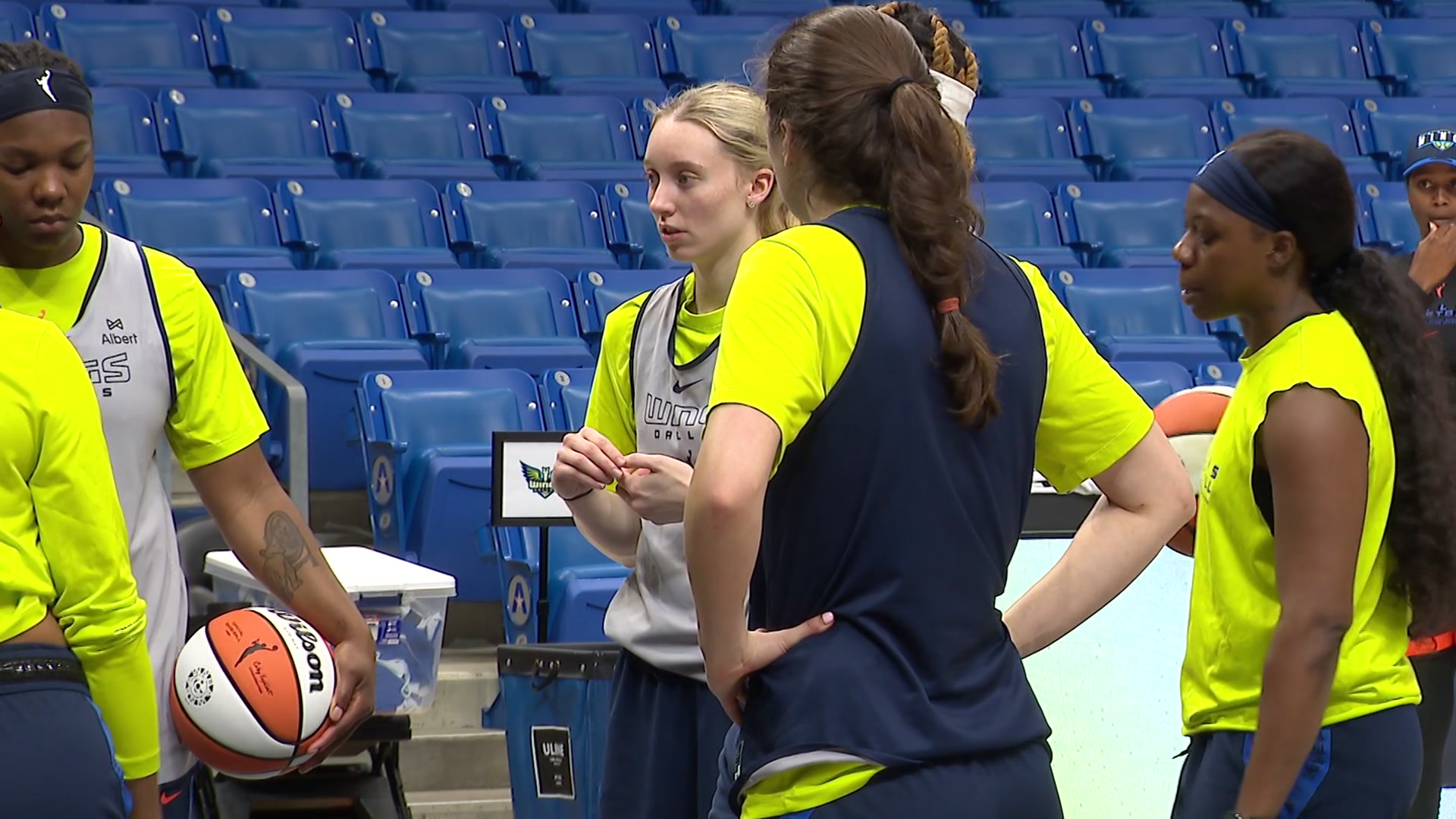For 12 years, John Almendarez's unidentified body was buried in a Houston pauper's cemetery under a grave marked "ML02-2230."
The Fort Worth Star-Telegram reports he was a father who shared his love of baseball and the Astros with his five daughters. They didn't see him again after a Father's Day visit in 2002.
His middle child, Alice Almendarez, was a teenager at the time and took on the heavy load of trying to find her father. She said police offered little help and the search often felt hopeless, even once leaving her in the morgue shouting for help. It consumed her life for more than a decade.
Unbeknownst to her, the only clue to the biggest mystery of her life was buried inside the Harris County Cemetery, which she drove past nearly every day.
But in 2014, she learned about NamUS -- a national clearinghouse and database for missing and unidentified deceased people headquartered in Fort Worth.
Once she discovered the clearinghouse, it took only six months for Almendarez to learn her father drowned in the Buffalo Bayou close to his home and that his body was found on July 2, 2002.
Only eight states require criminal justice agencies to enter case information into the National Missing and Unidentified Persons System. Texas is not one of them.
Local
The latest news from around North Texas.
Almendarez hopes that her 12 years of hell will lead to a law in Texas that would require that kind of data entry from Texas law enforcement agencies, and therefore alleviate the pain of other families. She has started to gather information and contact lawmakers to see what steps she could make in proposing the legislation.
But she's hopeful.
Alice Almendarez knew her father struggled with alcohol after her parents separated, but he always regularly called his daughters.
"About a week went by that we didn't hear from him," she said. "My mom was in the hospital, things were going on with our family and, you know, we just noticed that he hadn't been calling."
Once her mom was released from the hospital, they made a missing person's report at the Houston Police Department.
Almendarez was 16 at the time and was dogged in the search for her dad.
"A few months would go by and we'd file another report," she said. "We would go to our county morgue and try to see if there were any bodies that matched him and we were told there was nothing there."
No one made the connection between the body of a man found on July 2, 2002, and Almendarez's reports of a missing man in the same area.
In 2010, Almendarez went on another trip to the morgue. She was angry.
"I was just standing there frustrated, like somebody please just help us," she said. "It was just a whole big mess and people like me, at 18 at 21 at 25, I didn't know what I was doing. I was just trying to find my dad ... I was doing it alone."
The pain of searching for her father was sometimes too hard to handle. Almendarez said it would have been easier had her family known immediately that he died.
"We could have moved on," she said. "With my dad, it's like every day you wake up and you were just like, `Is he dead or alive?' You can't eat, you can't sleep. It tore my family apart. Every single day was just a fight to get through. . We didn't want to know he was dead. We wanted a miracle. But any closure was better than no closure at all."
While continuing her search, Almendarez's life as a teenager moved on. She went to classes, graduated high school, worked and tried to keep some normalcy in her life. She became a paralegal, lost her job, got another one, got married, had kids and struggled with how to tell them about Grandpa John.
Then, in 2014, Almendarez turned on a Lifetime movie called "Bringing Ashley Home," based on the true story of a woman's search for her missing younger sister. The woman, Libba Phillips, created the very real Outpost For Hope organization that helps reunite families.
Almendarez went to the organization's website.
"That's how I found out about NamUs, through a Lifetime movie," she said.
Almendarez immediately searched through the database and thought she found a possible match. So she went to the Houston Police Department to get her DNA extracted and sent it to the NamUs-affiliated UNT Center for Human Identification.
Six months later, she found her father.
NamUs was founded by the National Institute of Justice and is managed through the University of North Texas Center for Human Identification on the UNT Health Science Center campus. When a person goes missing, information about the case can be sent to NamUs by the investigating law enforcement agency.
As of Sept. 10, there were 1,314 missing persons cases in Texas (37 went missing in Fort Worth). Information about the cases in the database include a name, physical description, date of birth, picture, and circumstances of the case -- such as where the person was last seen or what he was known to be wearing.
Families of those who are missing can go onto the NamUs database to see if any of the unidentified deceased descriptions match the person they're searching for.
There were 1,621 unidentified bodies in Texas as of Sept. 10 and 46 in Fort Worth.
The database hosts a swath of information about the deceased -- date and location of where they were found, how they were recovered, an estimated age, year of death, height and weight, a physical description including if there are any identifying markers like tattoos, scars or birthmarks, the clothing and accessories found on the body and a sketch of the person's face, if available.
Oftentimes, law enforcement will enter the missing person's information into a law enforcement system known as NCIC, or the National Crime Information Center, but not into NamUs. The two systems don't interact with each other.
When a family member in Texas makes a missing person report, she can voluntarily have her DNA taken by the police and sent to the UNT Center for Human Identification in Fort Worth. But police aren't required to use the NamUs database.
The DNA is uploaded to the Combined DNA Index System (CODIS) and is searched continuously against profiles of unidentified persons, while the NamUs database stores other information for comparison, such as biometric records collected from dental offices and morgues, said B.J. Spamer, the director of NamUs.
If there's a potential match, NamUs can compare information and keep families from waiting months for results -- like Almendarez's six month wait.
Although NamUs wasn't operating in 2002 when John Almendarez went missing. Houston investigators sent a tissue sample for DNA analysis to the Texas Missing Persons DNA Database in 2005, the year he was buried in a plot at the Harris County Cemetery, according to a police report obtained by the Fort Worth Star-Telegram.
John Almendarez's information was entered into the NamUs system in 2007 when it became public. His daughter says if law enforcement told her about the system when she reported him missing again in 2010, her family could have had their lives back four years earlier.
"It would have changed everything," she said.
Instead, the case was closed because police said they couldn't reach Almendarez. She said detectives were going to the wrong address.
A giant evidence vault filled with DNA sits within the UNT Health Science Center. The vault is lined with rows of tall, black lockers filled with missing person cases from across the country.
A large freezer in the back of the vault stores wet evidence. Two custodians work inside the vault and constantly inventory the evidence.
Remains can be anything from the entire skeleton to a couple of bones or a cut of a bone.
Rodriguez and her team comb through 650 to 1,000 unidentified remains cases a year. The key is getting family members to send their DNA to the center for a match.
But having the unidentified remains sent to the center alone can help law enforcement push their case forward.
"Forensic anthropologists are looking for any kind of trauma that was inflicted and they can help with a cause of death or other identifying markers," Rodriguez said.
Those markers can range from something as broad as sex, approximate age and height to something specific, like a previous injury that might have led the deceased person to walk with a limp.
All of this work happens in Fort Worth, within walking distance of the NamUs office where 18 employees squeeze into a command center every day.
John Almendarez was found face down in the Buffalo Bayou by a person who was collecting water samples for the University of Houston, according to a police report. He had no identification on him and investigators were unable to determine an approximate age or race due to decomposition.
He was wearing an Astros shirt.
The case was handed to the Houston Police Department's homicide unit, separate from missing person cases.
Once she searched the NamUs database, Almendarez knew she found her father -- because of the location and date his body was found and because of a scar on his lower abdomen and a mole on his ankle.
"It was little things like that that matched up," she said, adding that she had a feeling her father would be wearing an Astros shirt.
Then the DNA came back as a match.
Finding her father -- and finding how early his body was found and how close he was to his home -- took a weight off her shoulders. But it also brought Almendarez a wave of anger.
"How does that happen?" she asked. "With all the technology and everything we have, how does that happen? I was really angry. I guess at that moment I was just yelling and saying, `How do you let this happen?' and I don't want it to happen to anyone else . we need some kind of law to make everybody have to use NamUs."
John Almendarez was known by three numbers for 12 years -- his gravestone (ML02-2230), his missing person case (1182738-10) and the police case when his body was found (092958302).
Now, his gravestone has his name on it.
Though their healing has begun, it's going to be a long road of recovery. But Almendarez can now tell her children about their Grandpa John -- they've even started to ask for stories about him.
"He was adopted as a baby," Almendarez said. "We never knew any of his biological family, but he was a great dad. He was hands on. He drank and liked sports, but he loved us. He had five girls and was a typical Mexican dad. The reason me and my sisters love baseball so much is because he would always take us to Astros games."
Almendarez doesn't have many pictures of her dad, but the ones she does have showcase a life of love -- a baby sitting on the front steps of a house, a young John with a mustache, John asleep and wearing a Santa hat and John holding his daughters in his arms with a giant smile on his face.



